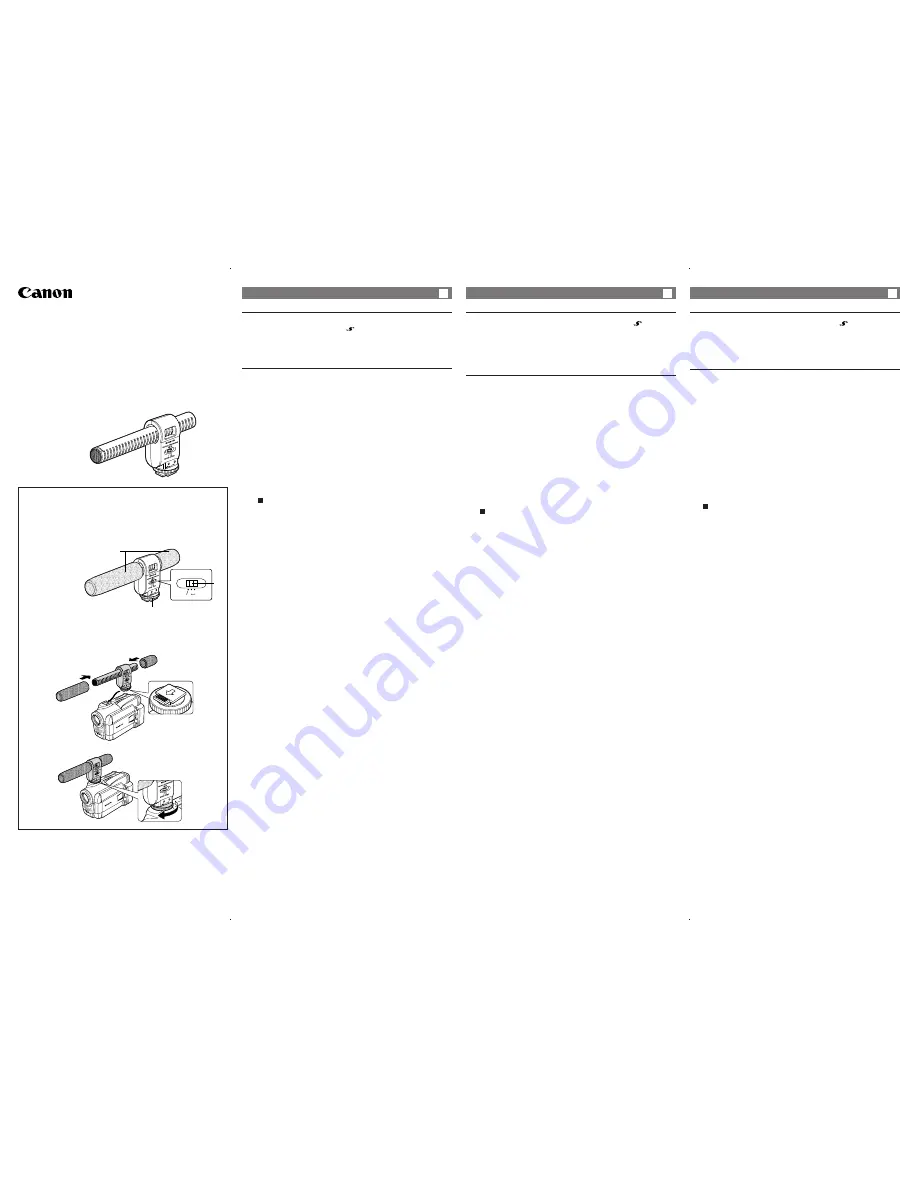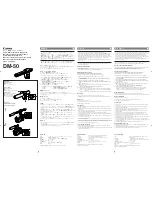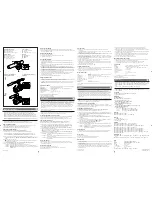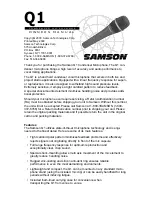
キヤノン 指向性 ステレオ マイクロホン
Canon Directional Stereo Microphone
Microphone stéréo directionnel Canon
Canon-Stereo-Richtmikrofon
Micrófono estereofónico direccional Canon
Microfono stereo direzionale Canon
佳能方向式立体声麦克风
DM-50
このたびは、キヤノン 指向性 ステレオ マイクロホン DM-50 をお買い上げいただきまして、
誠にありがとうございます。
この製品は、アドバンストアクセサリーシュー
を備えたビデオカメラ専用のマイクです。
高感度超指向性(モノラル)と中抜けのない、正面方向が高感度で明瞭に録音できるステレオ
特性との切り換えが可能です。録音する目的や場所によって、収音(録音)の特性を選ぶこと
ができます。マイクの電源は、ビデオカメラから供給されます。
ご使用になる前に、この使用説明書をお読みください。また、お読みになった後は、必ず保存
してください。
マイクは、ビデオカメラにバッテリーパックやACパワーアダプターなどの電源を取り付けて、
撮影または撮影一時停止中に使用できます。また、アフレコをするときにも使用できます。
ウィンドスクリーンについて
ウィンドスクリーンは、音質に影響なく、収音するときの風雑音を低減する効果がありますので、
常にマイクに取り付けてお使いください。
ウィンドスクリーンの取り付けかたは、左図をご覧ください。(図 1)
ビデオカメラへの取り付けかた
ビデオカメラの使用説明書もあわせてご覧ください。
¡
マイクを取り付け/取りはずすときは、ビデオカメラの電源を切ってください。
1
ビデオカメラのアクセサリーシューにマイクをまっすぐ差し込む(図 1)
¡
マイクの底面にある矢印の方向にカチッと音がするまで確実に差し込んでください。
2
マイクの締め付けねじを「LOCK」の矢印方向に回して固定する(図 2)
¡
締め付けねじを回しているときに、マイクが抜けないようにご注意ください。
3
ビデオカメラの電源を入れる
・ 撮影または撮影一時停止中に、液晶画面またはビューファインダーの画面下に
「
C
(CONNECTION)
」が出る。
¡
ビデオカメラの内蔵マイクは、自動的に「切」になります。
4
マイクの指向性切り換えスイッチを切り換える
・ SHOTGUN(ショットガン): 正面の音を明瞭に収音する。
(モノラルで収音されます。
)
・ ステレオ1
: 正面の音と周囲の音を適度に収音する。
・ ステレオ2
: ステレオ 1 より広く周囲の音を収音する。
収音前のチェック
¡
ビデオカメラのマイク端子になにも接続されていないことを確認してください。
¡
ビデオカメラにヘッドホン端子がある場合は、ヘッドホンでマイクが動作しているかどうかを声
を出して確認してください。
使い終わったら
1
ビデオカメラの電源を切る
2
マイクの締め付けねじを「LOCK」の矢印の逆方向に回す
3
ビデオカメラからマイクをまっすぐ引き抜く
ご注意
¡
ビデオカメラのマイク端子に他のマイクが接続されているときは、DM-50 から録音できません。
¡
アフレコをするときのマイクの使いかたについては、ビデオカメラの使用説明書をご覧ください。
¡
ビデオカメラにマイクを取り付けているときは、マイクを持ってビデオカメラを持ち運ばないでく
ださい。
¡
動作テストを行う場合は、マイクを叩いたり息を吹きかけたりせず、声で確認してください。
¡
マイクを落としたり、叩いたりしないでください。強い振動や衝撃は故障の原因となります。製
品はていねいに取り扱ってください。
¡
分解して内部に触れないでください。正常に作動しないときは、キヤノンサービスセンターにご
相談ください。
¡
直射日光下や炎天下の密閉された車内など、高温や多湿の場所で使用したり、放置しないでくだ
さい。
¡
ビデオカメラのアクセサリーシューに、金属片などが入らないようにご注意ください。また、マ
イクの底面に大きな力を加えないでください。
¡
ビデオカメラをケースなどに収納するときは、ビデオカメラからマイクを取りはずしてください。
お手入れ
¡
柔らかい布で乾拭きしてください。シンナー、ベンジン、アルコール等の揮発性のものは使用し
ないでください。
¡
マイクの底面の端子は、常にきれいにしておいてください。接触不良の原因となります。マイク
を取り付ける前に、柔らかい布などで乾拭きしてください。
Thank you for purchasing the Canon Directional Stereo Microphone DM-50.
This product has been designed exclusively for camcorders equipped with an
advanced
accessory shoe. It is a highly sensitive microphone that can be switched between functioning as
a directional microphone (monaural) or a stereo microphone that also clearly picks up sounds
arriving from the front of the microphone, for full recorded sound. Select the sound pick up range,
depending on the situation and your recording goals. The microphone is powered by the
camcorder’s power supply.
Before using the DM-50, read these instructions thoroughly and keep them in a safe place for
future reference.
The microphone is powered by the camcorder’s battery pack or power adapter. Use the
microphone when the camcorder is in record or record pause mode. You can use the
microphone for audio dubbing.
About the wind shields
The wind shields reduce wind noise without interfering with the microphone’s sound pick up abilities.
Use the wind shields regularly.
The illustration at the left shows how to attach the wind shields (Fig. 1).
Attaching the microphone
Refer to your camcorder instruction manual for more information.
¡
Turn the camcorder’s power off before attaching/removing the microphone.
1
Slide the microphone straight onto the camcorder’s accessory shoe (Fig. 1).
¡
Slide in the direction of the arrow on the bottom of the microphone until it clicks
securely into place.
2
Tighten by turning the shoe lock in the direction of the LOCK arrow (Fig. 2).
¡
Make sure that the microphone does not come disconnected when turning the shoe
lock.
3
Turn the camcorder’s power on.
•
C
(Connection) appears in the camcorder’s display when the camcorder is in record or
record pause mode.
¡
The camcorder’s built-in microphone automatically turns off.
4
Set the microphone’s directivity switch.
• SHOTGUN : Clearly picks up sound arriving from the front of the microphone. (Monaural)
• STEREO 1 : Picks up sound arriving from the front of, as well as sound surrounding the
microphone.
• STEREO 2 : Picks up sound surrounding the microphone in a wider range than STEREO 1.
Before use
¡
Make sure that nothing is connected to the camcorder’s microphone terminal.
¡
If you are using headphones to monitor sound, confirm the sound with headphones before you start
recording.
After use
1
Turn the camcorder’s power off.
2
Turn the shoe lock in the opposite direction from the LOCK arrow.
3
Slide and remove the microphone.
Precautions
¡
The DM-50 will not pick up any sound if another microphone is attached to the camcorder’s
microphone terminal.
¡
Refer to your camcorder’s instruction manual for information on how to use the microphone for
audio dubbing.
¡
When carrying the camcorder with the micropone attached, be sure to support the camera body.
Never carry the camera holding the microphone.
¡
Test the microphone by speaking into it. Do not tap the microphone or blow into it.
¡
Do not drop or jolt the microphone. This may damage the microphone or impair its performance.
Handle the microphone carefully.
¡
Do not disassemble or touch the interior parts of the microphone. Consult your Canon dealer or
service outlet if problems persist.
¡
Do not use or leave the microphone in hot, humid places such as inside a closed vehicle in hot
weather or in direct sunlight.
¡
Ensure that no foreign material such as metal fragments, gets inside the camcorder’s accessory
shoe. Be careful not to deform the plug or the bottom of the microphone by using excessive force.
¡
Do not store the camcorder with the microphone attached.
Care of the microphone
¡
Clean the microphone by dusting it lightly with a soft, dry cloth. Never use thinner, benzene,
alcohol or other volatile cleaners or solvents.
¡
The microphone will not work properly if the terminals are dirty. Check them before use, and wipe
them with a dry cloth if necessary.
Specifications:
Type
: Back electret stereo condenser shotgun microphone
Directivity
: Super-directional / Unidirectional stereo
Sensitivity
: -40 dB / Pa (0 dB = 1V / 1Pa, 1 kHz front, along axis)
Frequency
: 150 – 15,000 Hz
Output impedance
: 200
Ω
(1kHz)
Operating temperature range : 0
°
C – 40
°
C (32
°
F to 104
°
F)
Dimensions
: (W
×
H
×
L) 32
×
81
×
150 mm (1
1
/
4
×
3
1
/
4
×
5
7
/
8
in)
Weight
: 120 g (4
1
/
4
oz)
Weight and dimensions are approximate. Errors and omissions excepted.
Subject to change without notice.
主な仕様
型式
: バックエレクトレットコンデンサー型ステレオショットガンマイク
指向特性
: 超指向性 / 単一指向性ステレオ
感度
: -40 dB / Pa(0 dB = 1 V / 1 Pa、1 kHz 筐体軸上正面)
周波数特性
: 150 〜 15,000 Hz
出力インピーダンス: 200 Ω(1 kHz)
使用温度範囲
: 0 ℃〜 +40 ℃
寸法
: 約 32 × 81 × 150 mm(幅×高さ×長さ)
質量
: 約 120 g
仕様および外観は予告なく変更されることがありますが、ご了承ください。
使用説明書
J
Instructions
E
Mode d’emploi
F
Merci pour l’achat du microphone stéréo directionnel Canon DM-50. Ce microphone a été conçu
exclusivement pour les camescopes munis d’une griffe d’accessoires
. Il est extrêmement
sensible et peut, selon le réglage, fonctionner comme microphone directionnel (mono) ou
comme microphone stéréo, tout en captant aussi clairement les sons venant de l’avant du
microphone. La portée du microphone peut être sélectionnée en fonction de la situation et du but
visé. Ce microphone est alimenté par la source d’alimentation du camescope.
Avant d’utiliser le DM-50, veuillez lire ces instructions avec attention et les garder en lieu sûr
pour toute référence future.
Ce microphone est alimenté par la batterie rechargeable ou l’adaptateur d’alimentation secteur
du camescope. Utilisez-le lorsque le camescope est en mode d’enregistrement ou de pause
d’enregistrement. Vous pouvez aussi utiliser le microphone pour le doublage audio.
A propos des bonnettes antivent
Les bonnettes antivent réduisent le bruit du vent mais n’ont pas d’influence négative sur la capture
du son proprement dite. Utilisez régulièrement les bonnettes antivent.
L’illustration de gauche montre comment attacher les bonnettes antivent (figure 1).
Fixation du microphone
Consultez le mode d’emploi du camescope pour de plus amples informations.
¡
Mettez le camescope hors tension avant de rattacher/enlever le microphone.
1
Faites glisser le microphone tout droit dans la griffe d’accessoires du camescope (figure 1).
¡
Faites glisser le microphone dans le sens de la flèche au bas du microphone jusqu’à ce
qu’il s’encliquette.
2
Serrez la bague de verrouillage en la tournant dans le sens de la flèche LOCK (figure 2).
¡
Assurez-vous que le microphone ne se débranche pas lorsque vous tournez la bague
de verrouillage.
3
Mettez le camescope sous tension.
•
C
(connexion) apparaît sur l’afficheur du camescope lorsque le camescope est en mode
d’enregistrement ou de pause d’enregistrement.
¡
Le microphone intégré du camescope se désactive automatiquement.
4
Réglez le commutateur de directivité du microphone.
• SHOTGUN : Capture claire du son venant de l’avant du microphone. (Monophonique)
• STEREO 1 : Capture du son venant de l’avant et des autres côtés du microphone.
• STEREO 2 : Plage de capture du son environnant plus large que STEREO 1.
Avant l’utilisation
¡
Assurez-vous que rien n’est raccordé à la borne de microphone du camescope.
¡
Si vous utilisez un casque pour écouter le son, contrôlez le son par le casque avant d’enregistrer.
Après l’utilisation
1
Mettez le camescope hors tension.
2
Tournez la bague de verrouillage dans le sens opposé de la flèche LOCK.
3
Faites glisser le microphone et enlevez-le.
Précautions
¡
Le DM-50 ne captera pas de son si un autre microphone est rattaché à la borne de microphone
du camescope.
¡
Consultez le mode d’emploi du camescope pour de plus amples informations sur l’emploi du
microphone pour le doublage audio.
¡
Lorsque vous portez le camescope avec le microphone fixé dessus, soutenez le boîtier du
camescope. Ne saisissez jamais le camescope par le microphone.
¡
Pour essayer le microphone il suffit de parler devant. Ne tapez pas sur le microphone et ne
soufflez pas dedans.
¡
Ne laissez pas tomber et ne cognez pas le microphone. Il pourrait être endommagé ou ses
performances pourraient être réduites. Manipulez le microphone avec précaution.
¡
Ne démontez pas et ne touchez pas les pièces internes du microphone. Pour toute réparation
consultez un revendeur ou un service après-vente.
¡
N’utilisez pas et ne laissez pas le microphone dans des lieux chauds et humides, comme dans un
véhicule fermé par temps chaud ou en plein soleil.
¡
Assurez-vous qu’aucune matière étrangère, morceaux de métal, etc., ne rentre dans la griffe
porte-accessoires du camescope. Veillez à ne pas déformer la fiche ou le bas du microphone en
insérant le microphone de force.
¡
Ne laissez par le microphone sur le camescope lorsque vous rangez celui-ci.
Entretien du microphone
¡
Nettoyez le microphone avec un chiffon doux et sec. Ne jamais utiliser de diluant, benzène ou
autres produits ou solvants volatils.
¡
Le microphone ne fonctionnera pas normalement si les bornes sont sales. Avant de l’utiliser,
vérifiez les bornes et essuyez-les avec un chiffon sec, si nécessaire.
Fiche technique
Type
: Microphone électrostatique stéréo, de type canon, à
électret arrière
Directivité
: Superdirectionnel/Unidirectionnel stéréo
Sensibilité
: -40 dB
/ Pa (0 dB = 1 V / 1 Pa, 1 kHz avant, dans l’axe)
Fréquence
: 150 à 15.000 Hz
Impédance de sortie
: 200
Ω
(1 kHz)
Plage de température de fonctionnement : 0
°
C à 40
°
C
Dimensions
: (L
×
H
×
P) 32
×
81
×
150 mm
Poids
: 120 g
Le poids et les dimensions sont approximatifs. Sauf erreurs et omissions.
Sujet à changements sans préavis.
取り付けかた
Attaching the microphone
Fixation du microphone
DIRECTIONAL STEREO MICROPHONE
DM-50
SHOTGUN STEREO
1 2
q
w
e
1
2
各部の名称
q
指向性切り換えスイッチ
w
締め付けねじ
e
ウィンドスクリーン(大、小)
Nomenclature
q
Directivity switch
w
Shoe lock
e
Wind shields (1 large, 1 small)
Nomenclature
q
Commutateur de directivité
w
Bague de verrouillage
e
Bonnettes antivent
(1 grande, 1 petite)




















